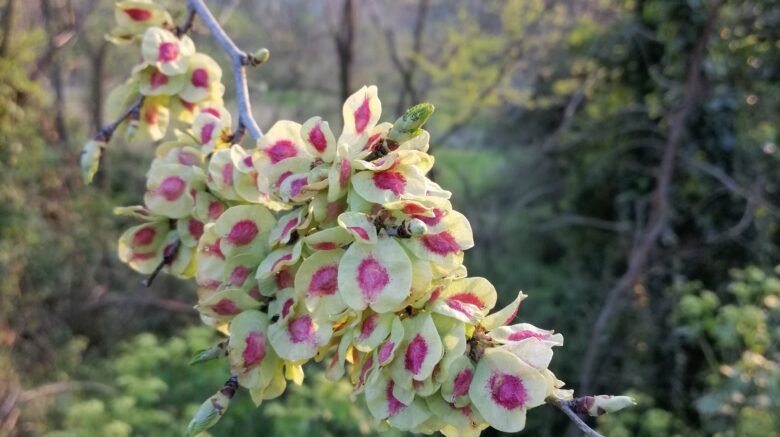Ulmus L. – Genus
Order: Rosales Bercht. & J.Presl (APG IV), Urticales Juss. ex Bercht. & J.Presl, 1820 (Cronquist)
Family: Ulmaceae Mirb.
Tribe: Ulmeae
According to World Flora Online, the genus Ulmus L. currently includes about 40 species of trees [WFO], which are generically called elms, mainly found in the temperate and tropical-mountain regions of Eurasia and North America.
Ulmus minor Mill.
|
Primary functionality: |
Mercury |
|
Secondary functionality: |
Saturn |
|
Nature: |
Neutral or slightly hot, dry |
|
Taste: |
Bland (mucilaginous), slightly sweet, bitter, astringent and salty, weakly aromatic |
|
Tropism: |
Skin, mucous membranes, serous membranes, connective tissue, nerves, muscles, synovial system, liver |
|
Humoral actions1: |
Regulates phlegm (eliminates perverted phlegm and provides correct phlegm), eliminates excess heat and the damp-heat of rottenness, provides correct melancholy |
|
Clinical actions: |
Abstersive, anti-rheumatic, astringent, demulcent, diuretic, laxative, purifying, remineralizing, tonic, vulnerary |
|
Used parts: |
Leaves, fruits, inner bark. |
Botany
Field elm (Ulmus minor Mill., syn.: Ulmus campestris Auct. Non L.) is probably the most polymorphic of all European elms. It is a very vigorous and long-lived tree (it can live up to 400-500 years) which in optimal conditions can grow 30-40 m high and the trunk diameter can get up to 1.5-2 m (in exceptional cases it can grow up to 45 m high and 3 m in diameter). More often, mainly in coppices and due to diseases2, it grows as a shrub or a small tree, in thickets formed by numerous root suckers, because of the large suckering ability of the species. [Acta]
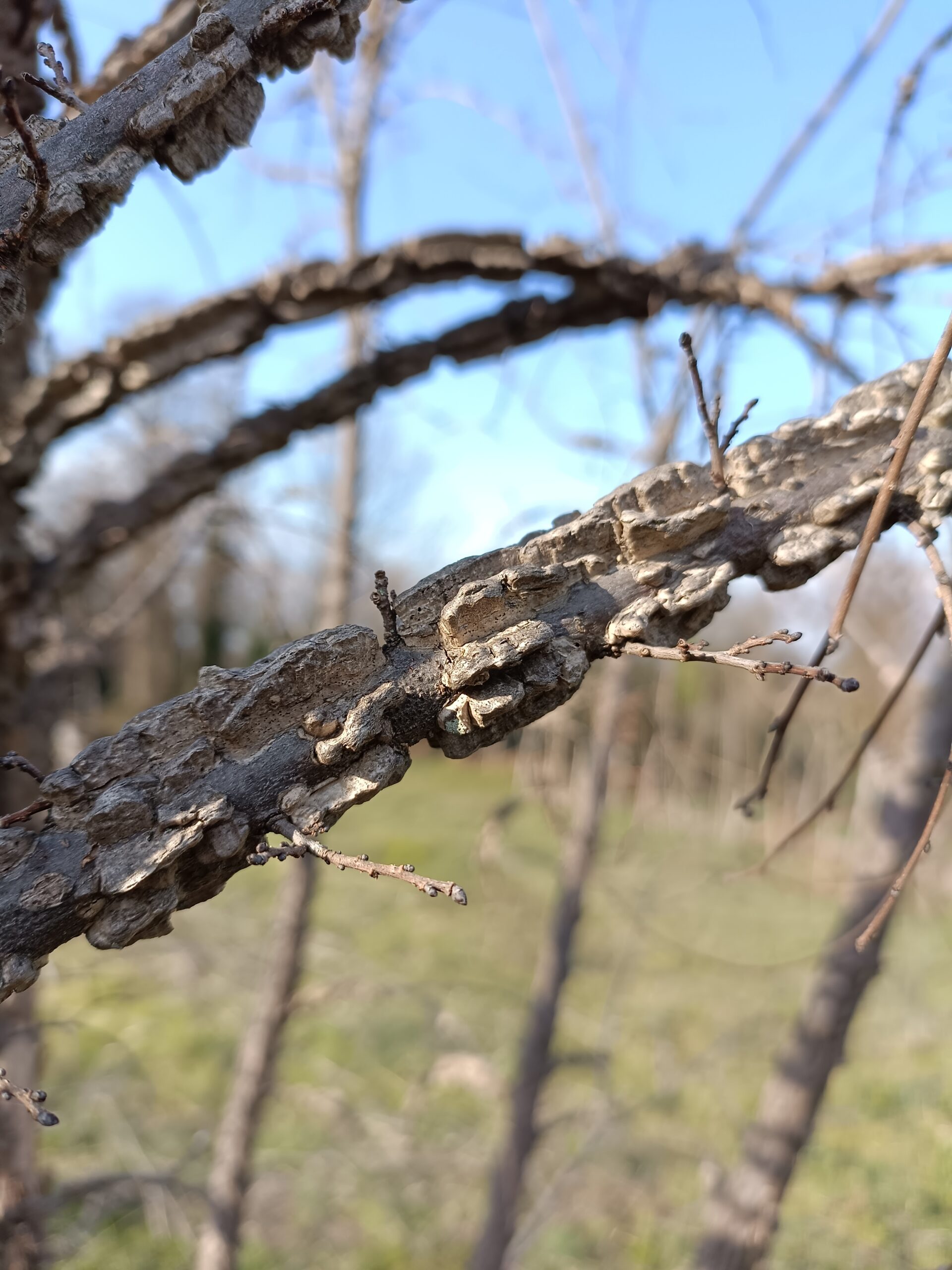
Viewed from afar, when it is covered with leaves, it has a profile that resembles that of oaks, so much so that at first glance the two trees could be confused with each other. If we get closer, however, we begin to notice important differences. First of all, some plants, especially when young, have rather thick corky formations on the bark of the trunk and branches that give the branches a “winged” appearance (fig. 1). Some authors have classified these plants as a variety (var. suberosa (Moench)) but this characteristic is now considered in the context of the intraspecific variability.
The arrangement of the branches and leaves is also particular. This tree has a growth that is defined as “monocase sympodial”3 and the twigs have a distichous arrangement, that is, instead of arranging three-dimensionally in all the possible space around the main branch, they grow in an alternating-opposite way on a plane. Furthermore, the branches are acrotonous (the distal ones are longer than the proximal ones). This gives the branches an almost “flat” appearance and a shape that vaguely reminds a sort of skeleton or a fishbone (figs. 2 and 3).
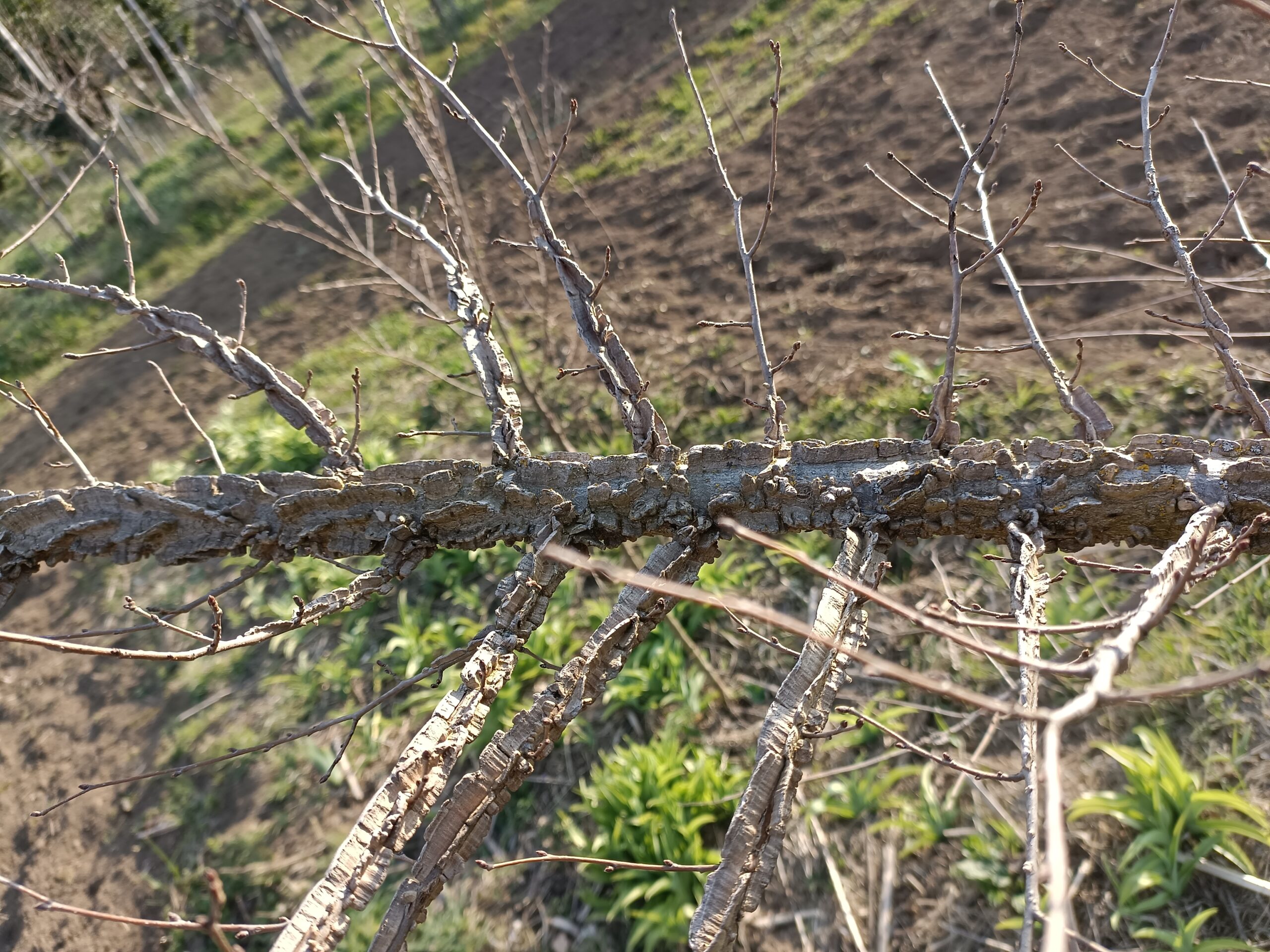
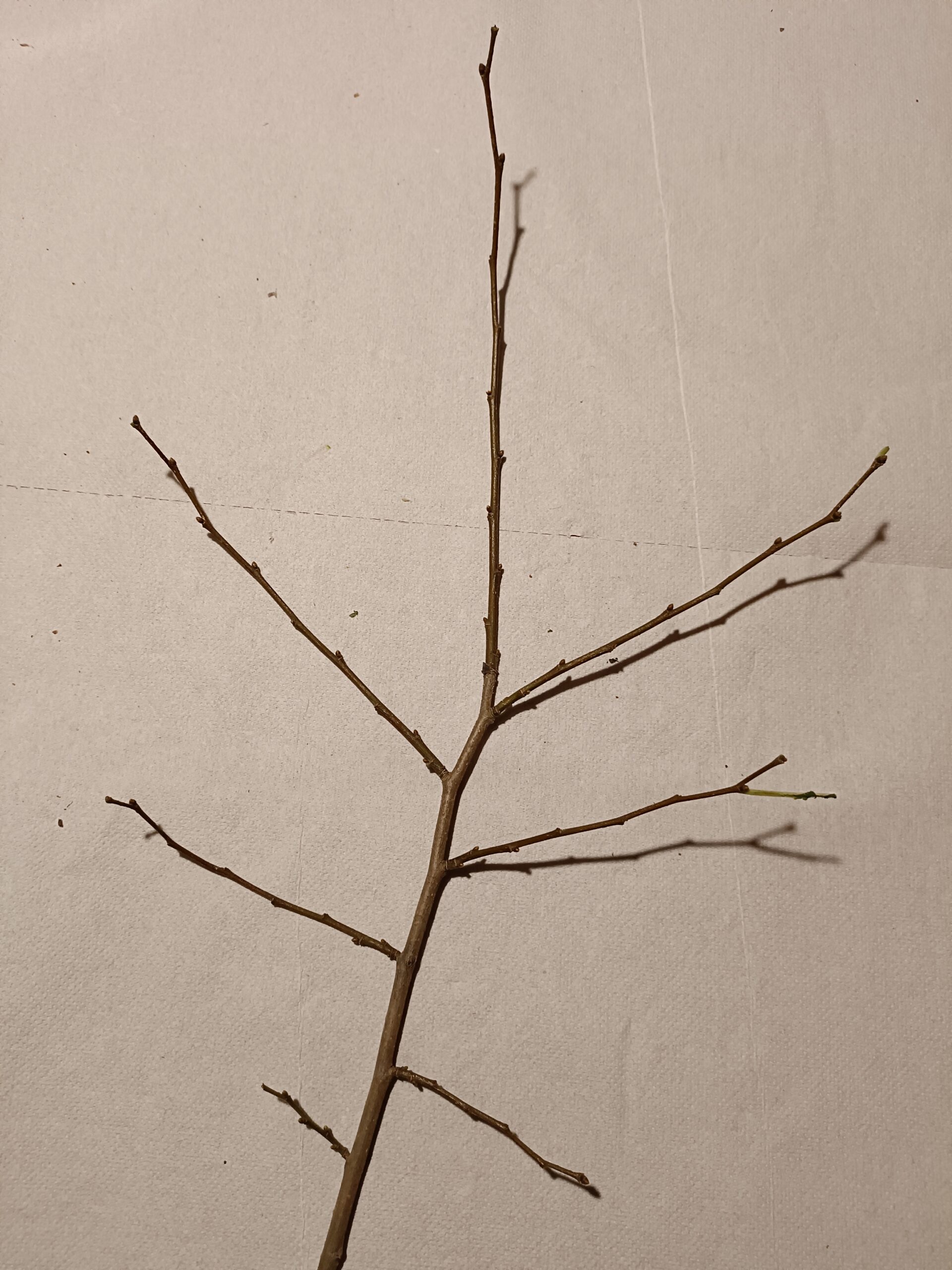
Similarly, the leaves of the elm also have a distichous arrangement too (so, with respect to the branch on which they grow, they are placed in an alternating-opposite way on a plane) and in addition, unlike what happens for most trees, they are decidedly asymmetrical with respect to the leaf axis: the leaf base is wider on the side towards the branch (in other words, if the bud from which the leaf originates was placed on the left on the branch, the right half of the leaf is more developed and vice versa). Even in the “domain” of the leaf, therefore, the elm creates a particular order (figs. 4 and 5).
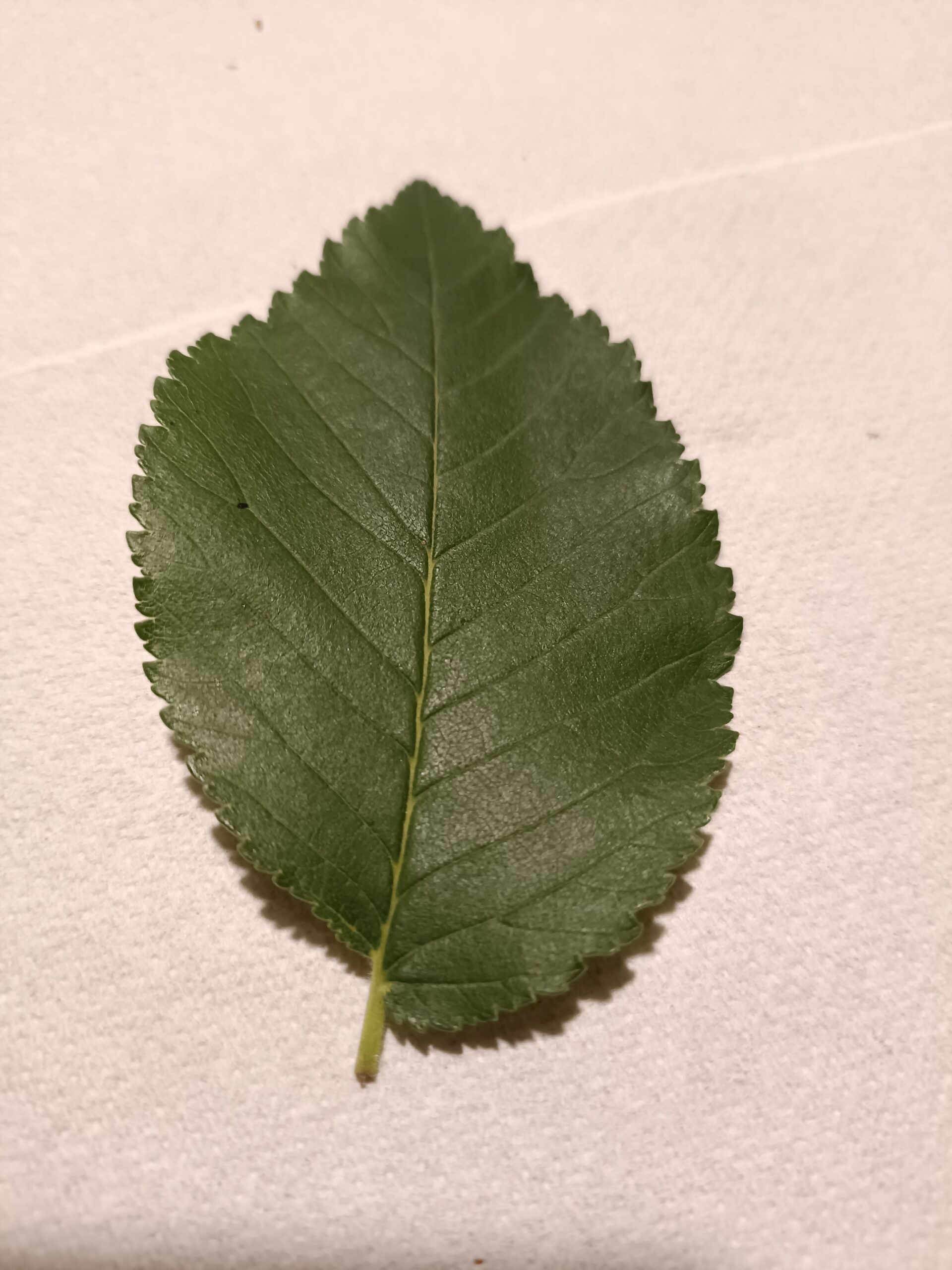 |
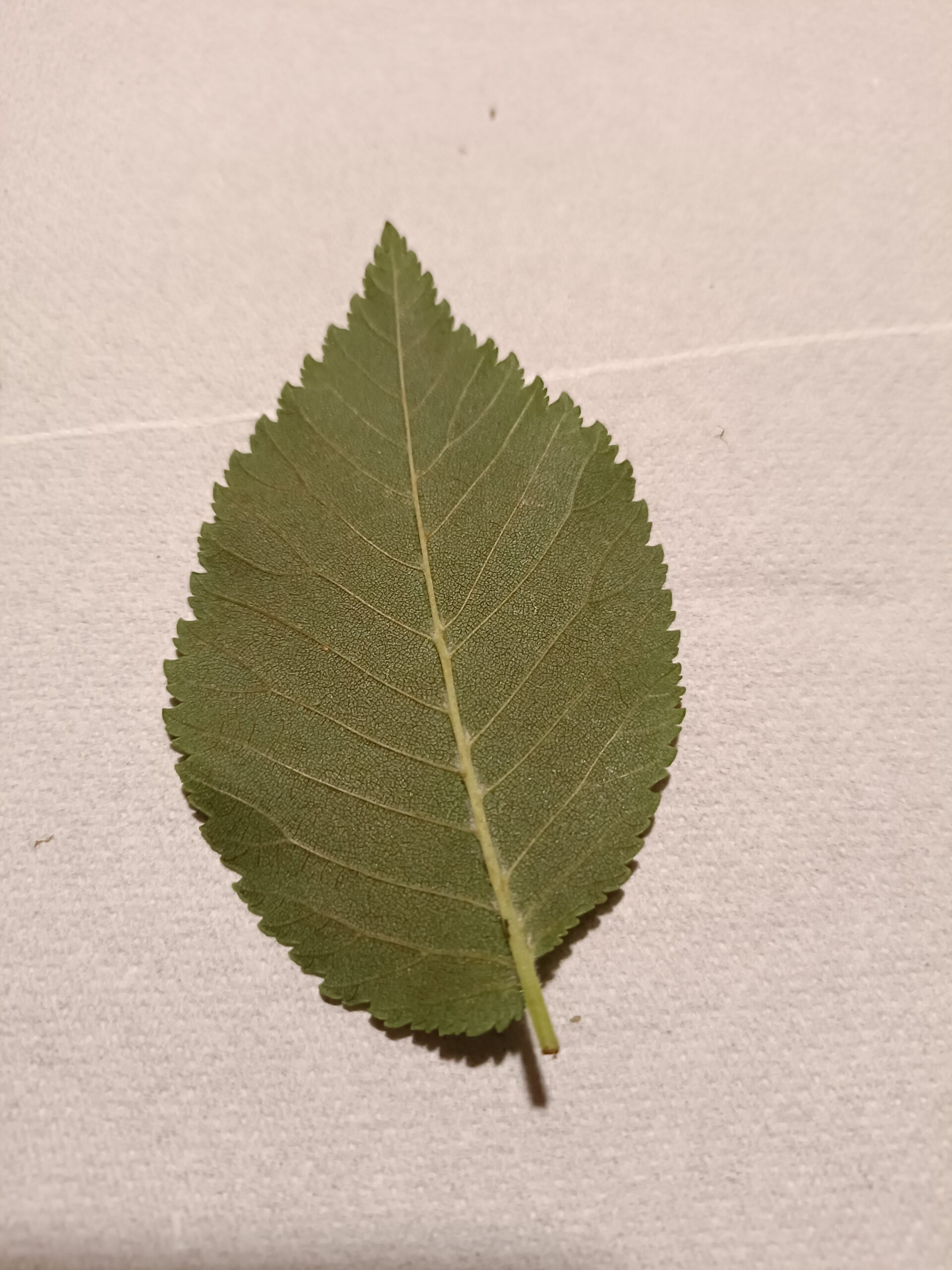 |
When we touch a mature elm leaf we can notice that the upper surface is rough and gives the impression of being covered with tiny scales that feel almost mineral to the touch, hard and with a certain rigidity. They seem quite not to belong to the soft “nature” of the leaf. This “mineral roughness” is a sign of the presence of a good quantity of silica in the plant. Ulmaceae, indeed, characteristically contain a certain amount of biogenic opaline silica (phytoliths) in the leaves [Geis]. A relatively high amount of silica is also present, in the form of simple or aggregate bodies, on the wings of Ulmus minor samaras [Guzmán-Delgado]. Elm ash (unspecified species) is particularly rich in silica (about 16%) and calcium salts (about 59%, such as CaO) [Colomban].
Furthermore, it seems that elm tends to accumulate silica from the soil: if the plant grows in an area particularly rich in this mineral (for example, in sandy soils), wood processing becomes particularly difficult, so much so that the tools used for cutting tend to lose their sharpness quickly. [CorteInverno]
The underside of the leaves, on the other hand, is often covered with a velvety tomentum that seems to communicate to the touch a certain soothing ability of the plant: indeed, this tree contains a lot of mucilage, both in the leaves and in the so-called inner bark (also known as phloem) of branches and trunk, which give elm-based preparations an important soothing and emollient capacity. Exerting a slight pressure with the tip of a fingertip or with a fingernail on the non-corky part of the bark of an elm branch, one can notice that the bark “gives” slightly under the pressure of the finger (as if it were made of a rubbery substance): this it is due to the presence of considerable quantities of mucilage in the inner bark. Although “hard” internally (wood), this tree is “softer” just below the surface.
Elm is hysteranthous, that is, it flowers before the leaves emerge. In the specific case of the elm, even the fruits begin to form before the leaves open: they are probably the first fruits of the year to appear, among non-therophytic plants.
The flowers, hermaphroditic and arranged in glomeruli, are purple-rust and appear from the end of February to the end of March. Many flowers are monoclamidate4. [Acta]
The flowers last a few days. The mature anthers are reddish and contribute to give the flower a rusty color; when the pollen is released, the anthers darken, giving the entire flower a “duller”, brownish color (see fig. 6). Within a few days the color of the flowers changes from rust to brown and then it changes again to green because of the appearance of young fruits.
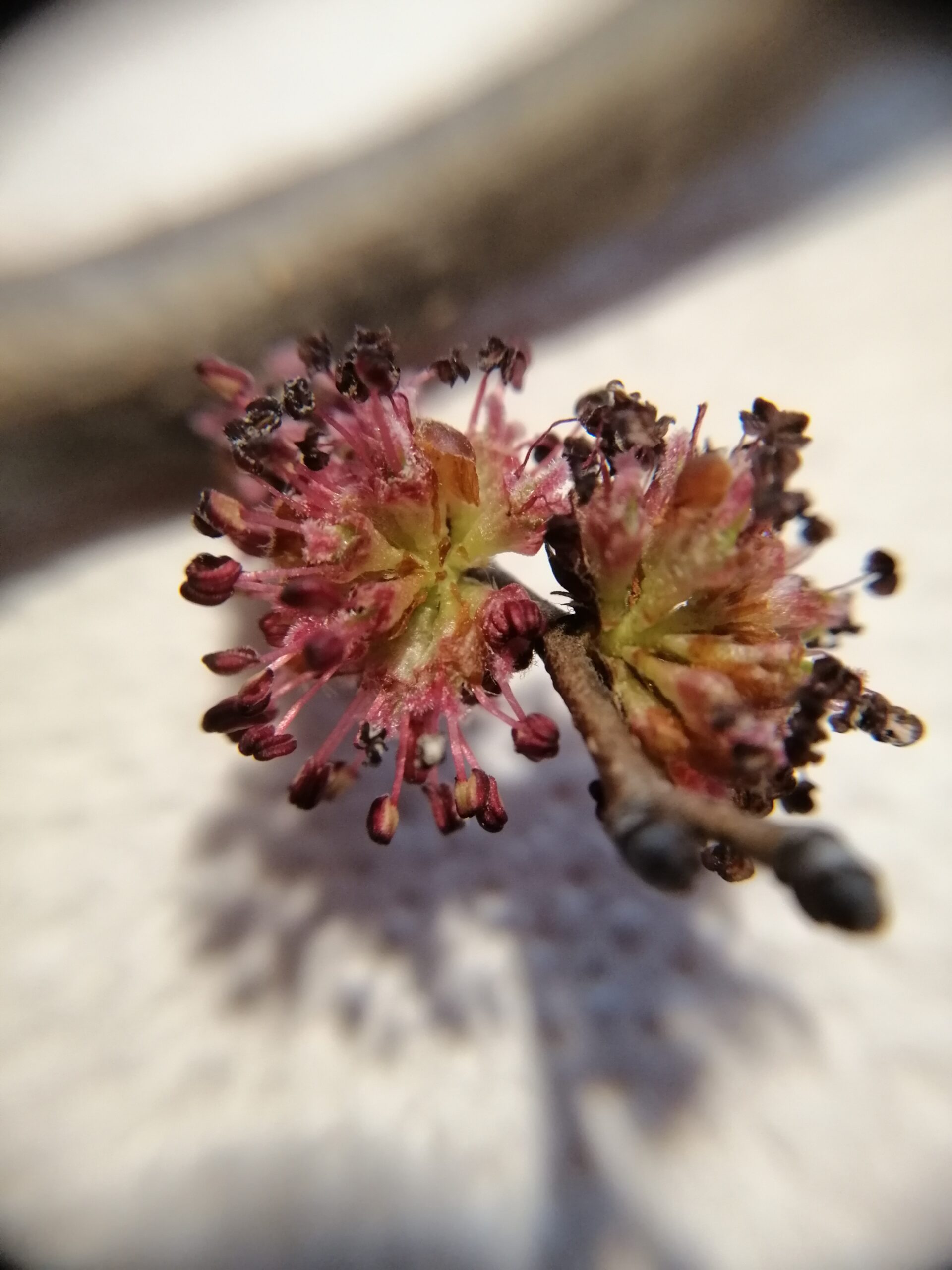
Pollination is anemophilous, even if the flowers are visited by bees because, although they lack nectaries, they are still rich in pollen (it is one of the first tree pollens available after winter rest, a critical moment for pollinating insects).
The fruit is a winged samara5, edible when immature and with a pleasant taste. Ripening takes place during the month of May and is almost always abundant, but the percentage of empty seeds is very high. The seeds are recalcitrant6 so they germinate immediately [Acta].
The wings of the elm samaras are greenish-yellow and this indicates that they are capable of photosynthesis (see for example [Guzmán-Delgado, López-Almansa]). This suggests that the formation of the carbohydrate reserve of the seed occurs (at least partially) by direct photosynthesis by the samara, evidently to make up for the lack of sugars in the plant caused by the lack of leaves during the first growth phase of the seed.
Description
The field elm is used infrequently today in herbal medicine, yet its therapeutic action is decidedly interesting.
Traditionally, the inner bark is used as an astringent, antirheumatic, diuretic, cicatrizing remedy, for the treatment of eczema and as a purifier [Piterà].
According to Dioscorides (as reported by Mattioli) “the leaves, the bark, and the branches of the Elm have the virtue of inspissating7. The leaves, chopped and applied with vinegar, medicate the scabies, and heal the wounds. Which thing is much better done by that thinner part of the inner bark when it is wrapped, like a band, since it folds so smoothly, as if it were leather. The thickest part of the bark, drunk at the weight of an ounce8 with wine or cold water, solves the Phlegm. The decoction of the branches, and likewise that of the root bark, applied as a fomentation, quickly consolidates broken bones. The humour that is found in its blisters9 while producing the first fronds, makes the skin beautiful and the face more splendid; but as it dries, it turns into certain little animals, almost similar to midges. Some people cook the leaves in their food, just like the other herbs in the gardens.” [Mattioli]
Pliny the Elder reports: “The leaves, bark and branches of the elm have the virtue of firming and healing wounds. The inner membrane between the wood and the bark mitigates leprosy: this is also done by the leaves steeped in vinegar. A denarius10 by weight of this bark drunk in a hemina11 of cold water purges the body, and brings out the phlegm, and especially the water. Its tear12 is placed where there is a collection13, and on the wounds; as well as on those burns, which are helped by a fomentation made with the cooked plant. […] The first small petioles of the leaves14, cooked with wine, heal the swellings, and pull out through fistulas. The membranes between the wood and bark have the same effect. Many believe that the bark chewed is very useful for wounds. The chopped leaves sprinkled with water are useful for swollen feet. Still, the humour that comes out of the marrow of a nicked tree, as we have said, smeared, makes the hair return to the head, and stops those who are about to fall.” [Pliny]
The ability of the elm to accumulate silica (or, if we prefer, its “affinity” with this substance and, in general, with the processes of silicon) certainly influences its properties: the plant, in fact, has the ability to stimulate the regeneration of both soft and hard tissues (it is indicated, for example, in the case of wounds and bone fractures), as well as the purification of connective tissue, the resolution of suppurative processes (especially if chronic) and the regulation of sweating (especially when the sweat produced is particularly foul-smelling due to dysbiosis/putrefaction processes or deposition of toxins in the connective tissue), similarly to what the Silicea15 remedy does in homeopathy. Being a plant with purifying properties and having also a nervous tropism, it has effect on herpetic forms (especially if chronic).
According to Simone Iozzi, the elm has a decisive influence on the purification of connective tissue and “its decoction drains at this level the toxins which cause the inflammatory reactive state underlying dermatological diseases with a typically chronic course with periodic seasonal aggravations. The fame of elm as a purifying plant is therefore widely deserved, especially when it is associated with detoxifying plants such as burdock, hepatic plants like dandelions or kidney plants such as restharrow. The elm is highly recommended for urticarial, dermatitic, professional skin diseases, etc.” [Iozzi, Iozzi2]
Elm exerts an important rebalancing action on the skin, the mucous and serous membranes (that is, on the tissues responsible for communication with the outside) and in this sense it helps eliminate the exudative colloidal toxins that drain through the integumentary emunctory. [Cemon]
According to Serge Dewit and Jean-Claude Leunis, elm is mainly a cutaneous-mucous drainage agent, but it also acts in disorders of the metabolism of nucleoproteins, making it suitable in the treatment of gout and rheumatism related to psoriasis. It is prescribed on precise biological and clinical indications objectified by a hyper-(α)βγ and hyper-γ profile. With Rosa canina and high doses riboflavin (300 mg/day) it is the remedy of choice for recurrent herpes. [Dewit-Leunis]
Wilhelm Pelikan, anthroposophist, provides a description of elm that helps us to more deeply understand the medicine of the elm, especially in its more subtle aspects: “The elm is similar to the oak in its connection to the solid, terrestrial, long-lasting element, yet this is obviously only one of its poles. Quickly turned on to flowering, quickly seized by the forces of ripening, eager to fade into the aerial element, here it is the other pole. The gravity of earth and the lightness of air, or, as once they used to say, “salt” and “sulfur”, both have their share. […] In the harmonious composition between thickening and rarefaction, the characteristic element of the essence of the elm can be experienced. There a flowing element stops, there something that has stopped flowing returns, a divided duplicity is connected and balanced through a third, superior, rhythmic element. Mercury is at home both on earth and in heaven, he tramples the earth, but with winged shoes. What the process of the elm creatively expresses inside the tree reveals with the utmost clarity within the rhythmic organ, in the leaf, in the form of a sensitive manifestation, such as expansion, contraction, as harmony within a total asymmetry”. [Pelikan]
And again: “In the elm wood […] something mercurial is frozen in the solid matter, one could say that it is enchanted within. […] It melts what is stiff, consolidates what is fleeting, lightens the dark, softens what flames, what blazes.” [Pelikan]
The glyceric macerate (gemmoderivate) of elm buds has an elective tropism for the skin, mucous and serous membranes, as well as for the muscular and synovial systems and for liver. It is able to resolve putrefaction, to transform or expell purulent collections and to resolve dermatoses (especially of the exudative type). It is also indicated in juvenile acne, gout, rheumatism and, preferably together with Alnus glutinosa, in (secreting) otitis, abscesses, fistulas, purulent sores, septic bronchitis with intensely colored sputum [Giannelli2, Piterà].
According to some Renaissance authors, the field elm and the wych elm (Ulmus glabra Huds.) have almost identical properties. In fact, Mattioli writes that “the elm is of two species, that is, field and mountain elm” [Mattioli], without making any distinction between the two species from the therapeutic point of view.
Properties
Temperature and taste
According to Culpeper, “it is a cold and Saturnine plant” [Culpeper]; John Gerard, instead, tells that “the leaues and barke of the Elme bee moderately hot, with an evident clensing faculty” [Gerard].
Castore Durante reports that “Elm has an astringent, & abstersive faculty: The bark is more bitter and more constricting.” [Durante].
In fact, the temperature of the plant is rather close to neutrality; the more bitter the specific part is used, the hotter it is, but always remaining within the first degree of heat. It is dry (in fact it “wipes up” what is too damp), but even with respect to this characteristic it remains balanced thanks to the abundance of mucilage it contains.
The flavor of the elm leaves is decidedly complex: at first, the sweet taste and the smell of coumarins are perceived, then the mucilage, the bitterness and, subsequently, a slight astringency and a certain salinity (similar in some ways to that of spinach). The latter is perceived more on the finish or as an aftertaste but it is persistent. In tincture, the sweetness is decidedly more intense. So we can say that the flavor of elm leaves is decidedly bland (mucilaginous), slightly sweet, bitter, astringent and saline, and weakly aromatic. Sweetness and bitterness are more pronounced than astringency; the latter, while not intense, is decidedly persistent, like salinity.
Chewing the ripe leaves, the sensation of “mineral roughness” typical of silica (a characteristic which is not classified as a flavor) is particularly evident.
Shortly after being harvested, the leaves give off a strong and characteristic sweet smell that indicates the presence of coumarins, molecules that give the plant a thinning activity on organic fluids (but they are not anticoagulant!); when broken or crushed, for example while making a hydroalcoholic tincture, the leaves instead give off a smell that is decidedly more similar to that of organic acids (e.g. oxalic), which denotes, in this case, a “refreshing” ability.
Signature
Myths and symbology
Elm has a rather complex symbolism. The Greeks and Romans associated it with the gods of sleep: Hypnos in Greek, Somnus or Sopor in Latin, or, according to some authors, with Morpheus or Oneiros, both sons of Hypnos and/or Nyx (goddess of the Night, Nox for the Romans) and therefore Hypnos’ brothers, depending on the specific versions of the myth (see also [Cattabiani]).
At the entrance to Hades, where “consanguineus Leti Sopor” (“Sleep, relative of Death”16) dwells, Virgil places an enormous elm under whose leaves the dreams of men reside:
“in medio ramos annosaque brachia pandit / ulmus opaca, ingens, quam sedem Somnia vulgo / vana tenere ferunt, foliisque sub omnibus haerent.17” (Aeneid VI, 282-284)
The connection with dreams made the elm a tree of oracular power. Perhaps due to an extension of this power, in the Middle Ages the elm became, together with the Jovian oak, the tree under which justice was administered. The expression “judges under the elm” indicated the judges without a court who exercised their offices seated under an elm (or near it) which was often even planted for the purpose in front of the castle doors. [Cattabiani]
The planetary signatures of the elm
From an archetypal point of view, elm is considered “a cold and Saturnine plant” by Culpeper [Culpeper], while, according to anthroposophy, it is mercurial [Pelikan], and is therefore linked to the figure of Hermes/Mercury, the winged divine messenger that puts the gods in communication with each other and/or with men. In order to make things more complex, some spagyric authors tell that the elm is decidedly jovian (Angelo Angelini even claims that “it is a typically Jovian plant, with a marked Martian influence.” [Angelini]).
Certainly it is a tree with quite complex features: similar to oaks in shape and strength (see also [Pelikan]), it has an important purifying ability (typically jovian) and a hepatic tropism, and it is able to intervene on certain metabolic processes.
However, its action is definitely aimed mainly at the organic structures that lay at the of interface between the internal and external world (skin, mucous membranes), between the organs (serous membranes) and between the joint heads (synovial apparatus), to the connective tissue that “connects” the different organic districts, and to the nervous tissue (it acts for example on herpes)18. These features make it a decidedly mercurial tree.
Elm is characterized by the presence of “excessive” formations, so much so that it appears warty or gnarled at the mere glance (see also fig. 7): in addition to the corky formations of the bark, the flowers, too, resemble rusty warts or knots. The presence of these formations, the particular (almost essential and “rigid”) structure of the branches, the shape and arrangement of the leaves make us understand that the elm tree is particularly linked to the “principle” of structuring: it takes advantage of the space that it is granted not in an “undisciplined” and “casual” way, but in a specially ordered way, even structuring itself in a more “intense” way with respect to what other trees do.
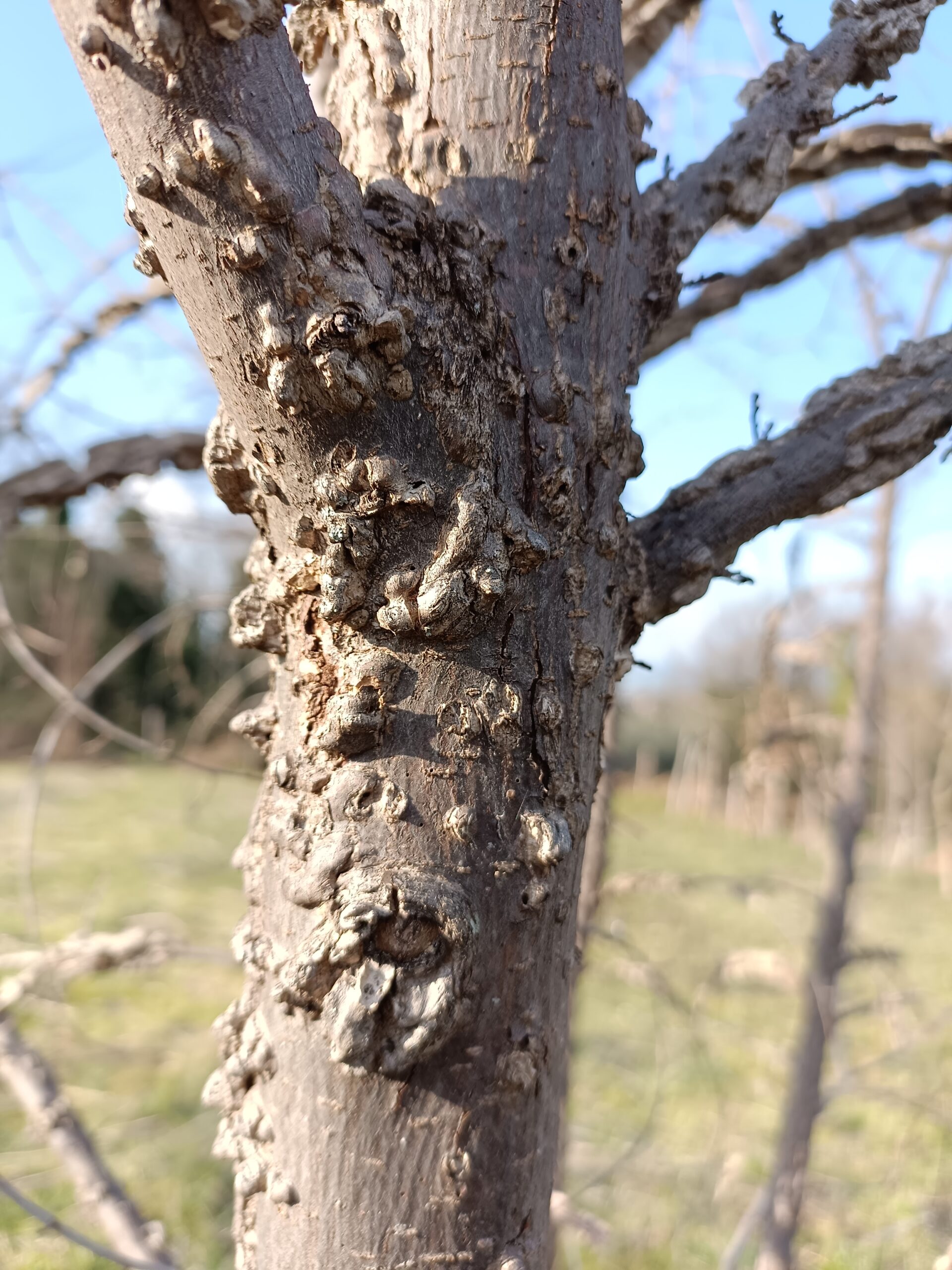
These traits just described, together with the “mineral” roughness of the leaves and the particular affinity of the plant for silicon19, give the idea that the elm is definitely a “tree of form”, that is, a tree that is particularly sensitive, in some way, to the plastic forces of formation20 which act on plant tissues but also, by reflex, when the plant is used as a medicine, on human tissues.
These plastic forces, in the elm, are not oriented only towards hardening and structuring, but seem to organize themselves around two opposite poles: on the one hand, the pole of the siliceous hardness and of the tendency of the plant to “hyper-formation”, on the other hand, the pole of the softness of the mucilage which are (even sensibly) present just under the surface of the bark and in the leaves. This polarization is also reflected on the therapeutic level: the elm, in fact, has the ability both to soften the “hardness”21 and to harden and consolidate what is softened or even fractured. Thanks to this ambivalence, the elm teaches man the ability to structure himself but also to make himself malleable and to know how to “change shape” when circumstances require it.
This typically mercurial22 coexistence of opposite aspects is a characteristic of the elm that we have already encountered in Wilhem Pelikan’s description of the tree (see paragraph “Description”).
It is interesting to note that the elm has also been associated with Morpheus, the god of dreams. The name of this divinity derives from the Greek μορφή (morphé) which means precisely “form”, due to his ability to take the form of people in the (closed) eyes of sleeping men23.
The ability of elm to act in a bivalent manner on the structuring forces, its very affinity for silicon (an element necessary for the formation of rocks), its “dark” presence that makes Virgil place it at the entrance to the Hades, its ability to act subtly on the pineal gland certainly also places this tree in a decidedly saturnine24 context.
For the reasons explained so far, in this text the elm will be considered a mainly mercurian tree with secondary saturnine functions.
It is interesting to note that the deities to which the elm is connected are mostly represented as young men endowed with wings and, therefore, able to transport themselves from one part of the world of mortals and/or the world of gods to another “in a flapping of wings” (i.e., at once). Morpheus, in fact, “was a winged god, with large wings that flapped silently, taking him to every corner of the earth in an instant” [Cattabiani]. Hypnos and Somnus were also represented as young men with a pair of wings (on their back or head, depending on the myth). Mercury/Hermes “tramples the earth, but with winged shoes” [Pelikan]. As usual, the archetypal references of plants (the signatures) manifest themselves on the therapeutic and symbolic level but also on the physical level: it is probably no coincidence that the fruits of the elm are provided with wings and that the branches of young individuals appear “winged” due to the corky growths of the bark.
Tissue Phases
4 (fibrosis), 5 (necrosis) [Dewit-Leunis]
Actions and indications
Humoral actions
Elm exerts a bivalent action on phlegm: on the one hand it eliminates the perverted (thickened or in excess) humor and on the other it provides, with its mucilage, correct phlegm. Thanks to this ability to provide correct phlegm, the plant exert a nourishing tonic action on the body25. It has a gentle but important demulcent and soothing action, which makes the plant able to act on irritation and inflammation (excess heat), especially at the level of mucous membranes, skin, serous membranes and joints. The elm is abstersive and therefore it eliminates, besides excess phlegm, also the damp heat of rottenness (infections). It significantly stimulates the production of correct melancholy.
Tropism
The field elm has an elective tropism for the “interface” structures, i.e. skin, mucous and serous membranes, connective tissue, synovial apparatus, but also for the nervous tissue, muscles and liver. [Cemon, Piterà]
Clinical actions
Abstersive, Anti-rheumatic, astringent, demulcent, diuretic, laxative (bland), purifying, remineralizing, tonic, vulnerary.
Principal actions
- Tonic [Grieve]
- Demulcent [Grieve]
- Astringent [Grieve, Piterà]
- Diuretic [Grieve, Piterà]
- Anti-rheumatic [Piterà]
- Remineralizing [Cemon, Piterà]
- Vulnerary, cicatrizing (leaves, decoction of leaves, branches, inner bark, liquid contained in the galls); in case of swelling, abscesses, wounds, fractures, burns, ruptures: [ARSIA, Culpeper, Mattioli, Piterà, Pliny]
- Liter.: “The leaves, the bark, and the branches of the Elm have the virtue of inspissating” (Dioscorides) [Mattioli]
- Liter.: “The leaves, chopped and applied with vinegar, medicate the scabies, and heal the wounds. Which thing is much better done by that thinner part of the inner bark when it is wrapped, like a band.” (Dioscorides) [Mattioli]
- Liter.: “The decoction of the branches, and likewise that of the root bark, applied as a fomentation, quickly consolidates broken bones.” [Mattioli]
- Liter.: “The fluid, which distills from the tree, is placed on purulent collections, on wounds, and on burns, which still benefit from the fomentation of decoction.” [Pliny]
- Liter.: “The buds of the first leaves cooked in wine heal the swellings, resolving them insensibly through the pores of the skin. The leaves, chopped, and sprinkled with water, are usefully smeared on foot swelling.” (Pliny) [Mattioli]
- Liter.: “The liquid from the bladders heals intestinal ruptures in children, if, by wetting in it small pieces of cloth, they are oftentimes placed under the jockstrap tightly tightened.” [Mattioli]
- Liter.: “The humours obtained from the “galls” are applied to the wounds to stimulate their healing.” [ARSIA]
- Liter.: “The decoction of the bark in water, is excellent to bathe such places as have been burnt with fire.” [Culpeper]
- Laxative (bland: purge phlegm and excess fluids) [Mattioli, Pliny]
- Liter.: “The thickest part of the bark drunk at the weight of one ounce with wine, or with cold water, solves the phlegm” (Dioscorides) [Mattioli]
- Liter.: “A denarius by weight of this bark drunk in a hemina of cold water purges the body, and brings out the phlegm, and especially the water.” [Pliny]
- Purifying [Cemon, Iozzi, Iozzi2, Piterà]:
- It drains the skin, mucous and serous membranes, and connective tissue [Cemon, Iozzi, Iozzi2]
- It stimulates the connective tissue drainage (especially in the case of chronic dermatological diseases) [Iozzi, Iozzi2]
- Liter.: “It helps to eliminate the exudative colloidal toxins that drain through the integumentary emuntorium; useful in case of: exudative eczema, skin infections (acne, boils, ulcers), bullous eruptive diseases (chicken pox, herpes and shingles), dry dermatitis (psoriasis, keratosis in general)”. [Cemon]
- It assists detoxification by acting on the liver, it decreases cholesterol and uric acid. [Cemon]
- It drains the skin, mucous and serous membranes, and connective tissue [Cemon, Iozzi, Iozzi2]
Specific indications
General
- Remedy for any inflammatory state in the exudative phase (Pol Henry) [Piterà]
- Regulation and detoxification of the extracellular matrix [Piterà]
- Fatigue [Scholten]
- Problems with mucous membranes [Scholten]
- Hard tumours [Scholten]
Eyes
- Herpetic keratitis (adjuvant) [Piterà]
- Ocular herpes [Piterà]
- In order to improve visual acuity (a few drops of bark decoction are instilled in the eyes) [ARSIA]
Ears
- Otitis (secreting, with Alnus glutinosa) [Giannelli2]
Respiratory system
- Exudative pleurisy (adjuvant) [Piterà]
- Sore throat (gargling with bark decoction) [ARSIA]
- Bronchitis [Scholten], septic bronchitis with sputum of intense color (with Alnus glutinosa) [Giannelli2]
Cardio-circulatory system
- Pericarditis (adjuvant) [Piterà]
Gastrointestinal system
- Diarrhea, dysentery [Piterà, Scholten]
- Inflammatory bowel disease [Scholten]
Metabolism
- Nucleoprotein dysmetabolism, hyperuricemia, metabolic overload [Piterà]
Skeletal and osteoarticular system
- Bone fractures [Mattioli]
- Gout, articular pains [Culpeper, Dewit-Leunis, Mattioli, Piterà]
- Liter.: “the decoction of the bark of the Roots softens the hardened joints, and the nerves contracted, wetting them with it, or fomenting the places of pain” [Mattioli]
- Liter.: “The decoction of the bark of the root fomented, mollifieth hard tumours, and the shrinking of the sinews.” [Culpeper]
- Liter.: “The said bark ground with brine and pickle, until it come to the form of a poultice, and laid on the place pained with the gout, giveth great ease.” [Culpeper]
- Remineralizing action [Piterà]
- Synovite [Piterà]
- To strengthen the limbs of children who are about to take their first steps (decoction of bark in invigorating baths) [ARSIA]
Limbs
- Formication in feet, numb, creeping pain in legs and feet [Boericke]
- Numbness, tingling, and full soreness where gastrocnemius gives off its tendon [Boericke]
- Rheumatic pains above wrists [Boericke]
Urogenital system
- Vaginal catarrhs [Piterà]
- Cervicitis [Piterà]
- Vicariant leucorrhoea [Piterà]
- Genital herpes [Piterà]
Immune system
- Herpes simplex and zoster [Piterà]
- Hyper-γ-globulinemic syndrome with a tendency to fibrosclerosis[Piterà]
- Chickenpox [Piterà]
Central nervous system
- Improve paradoxical sleep (F. Ledoux e G Guéniot). [Piterà]
Skin and mucous membranes
- Wet and exudative or dry dermatosis and dermatitis: eczema (especially exudative), keratosis, urticarial skin diseases, skin infections (acne, boils, ulcers) [Cemon, Iozzi, Iozzi2, Piterà]
- Chickenpox, herpes simplex, herpes zoster; relapsing herpes (with Rosa canina and high doses – 300 mg/die – riboflavin) [Cemon, Dewit-Leunis, Piterà]
- Psoriasis [Cemon, Dewit-Leunis]
- Scabies [Mattioli, Pliny], scurf [Culpeper, Scholten], leprosy [Culpeper, Pliny, Scholten], ringworm [Grieve, Scholten]
- Liter.: “The inner part of the bark heals scabies, as do the fronds applied to it with vinegar.” [Pliny]
- Liter.: “The leaves thereof bruised and applied heal green wounds, being bound thereon with its own bark. The leaves or the bark used with vinegar cureth scurf and leprosy very effectually” [Culpeper]
- Liter.: “Was formerly employed for the preparation of an antiscorbutic decoction recommended in cutaneous diseases of a leprous character, such as ringworm. It was applied both externally and internally.” [Grieve]
- Acne (juvenile, inverse, pustular, rosacea) [Piterà]
- Aphthae, aphthous stomatitis [Piterà]
- Seborrheic alopecia [Piterà]
- Milk crust [Piterà]
- Axillary hidradenitis suppurativa [Piterà]
- Impetigo [Piterà]
- Changes in the composition of sweat, foul-smelling perspiration, acid sweating [Piterà]
- Mucositis [Piterà]
- Urticaria [Piterà]
- Oily and shiny skins [Piterà]
- Ichorous, purulent sores [Giannelli2, Piterà]
- Skin ulcerations, wounds [ARSIA, Mattioli, Pliny, Piterà]
- Skin burns [Culpeper, Piterà, Pliny]
- Eczematous flush [Piterà]
- Abscesses, fistulas (with Alnus glutinosa) [Giannelli2]
Other
- Chilblains (bark decoction, compresses) [ARSIA]
- Cosmetic use (liquid contained in the galls) [Mattioli]
- Liter.: “The humour that is found in its blisters while producing the first fronds, makes the skin beautiful and the face more splendid” (Dioscorides) [Mattioli]
- Hair thinning (stimulates hair regrowth) [Culpeper, Pliny]
- Liter.: “The humour that comes out of the marrow of a nicked tree, as we have said, smeared, makes the hair return to the head, and stops those who are about to fall.” [Pliny]
- Liter.: “The roots of the elm, boiled for a long time in water, and the fat arising on the top thereof being clean scummed off, and the place anointed therewith that is grown bald, and the hair fallen away, will quickly restore them again.” [Culpeper]
- Food use (leaves, cooked) [Mattioli]
- Liter.: “Some people cook the leaves in their food, just like the other herbs in the gardens.” (Dioscorides) [Mattioli]
Parts used and their collection
The leaves are preferably collected in summer; the inner bark is harvested in autumn from branches a few years old; the fruits must be harvested when fully ripe, but before they begin to dry out. The collected parts are dried in the shade and can be stored in paper or cloth bags, away from moisture, or in glass containers.
A medicinal tea was also formerly made from the flowers. [Grieve]
Preparation and dosage
The inner bark can be used in decoction or in powder form. The leaves and fruits in decoction, infusion or tincture. The fruits can be used freely as food, preferably raw. The tender leaves can be cooked and used as a vegetable.
Contraindications and collateral effects
Elm is considered generally safe. There are no known side effects or interactions of any kind. For the American red elm bark (Ulmus rubra Muhl), it is advised not to exceed with it, in order to avoid that the substances contained in the drug can interfere too much with the absorption of food nutrients: it is recommended not to take it for longer than 21 days [Wood]. Such a precaution can also be useful for field elm bark.
Gemmotherapy
In gemmotherapy, the leaf buds of the field elm are used. The indications and features of the glyceric macerate of Ulmus minor (generally called in this context with the synonym Ulmus campestris) are presented below and are taken from [Piterà].
Main features
Cytological and histological action: stimulates Kuppfer’s liver cells. Removes the metabolic blockade that can occur in the early stages of hyper-γ-globulin fibrosclerosis by reactivating hepatic macrophages (Kuppfer)(Pol Henry).
Biological activity: It has a marked action in disorders of nucleoprotein catabolism: uric acids, gout and urea. Acts on ionized calcium.
Action on coagulation and thromboelastogram: slight ambivalence on the constants of the thromboelastogram (T.E.G.)
Stimulated cell lines: stimulates Kupffer’s liver cells, lymphoplasmacytoids.
Lipid and lipoprotein metabolism: reduces slightly increased β-lipoproteins; has a secondary action on cholesterol.
Protein metabolism: increases albumins, reduces hyper-α1γ-globulinemia; decreases hyper-α2γ-euglobulinemia; action on nucleoproteins.
Main properties and essential clinical indications
Ulmus campestris is the remedy for hyper-α1γ-globulinemic and hyper-β-lipoprotein syndromes.
It is an excellent drainage agent for the skin, mucous and serous membranes, acting in various diseases and regulating the secretion of the sebaceous glands. It regulates the body’s tendency in the reaction phases to transfer endogenous disturbances to the skin in the form of non-infected vesicular eczema (regressive vicariation).
It is therefore indicated in skin syndromes of allergic or inflammatory origin, especially affecting the sebaceous glands, in the treatment of juvenile acne, moist, icorous dermatitis and dermatosis, herpetic lesions, etc.
It also acts on other elimination processes of “functional metastases” such as leucorrhoea, mucositis and diarrhea: in cases where these functional metastases do not find a way of elimination, a “latent impregnation” occurs at the tissue level (progressive vicariation), the first phase of fibrosclerosis from hyper-γ-globulinemia.
It also has a marked action in disorders of the catabolism of nucleoproteins and is therefore active in hyper-uricemic and gouty syndromes, in dysmetabolism, in some rheumatic forms and in all functional diseases related to the dysmetabolism of nucleoproteins. It has a secondary action on urea and cholesterol. U. campestris balances this trend with a probable enzyme unblocking reaction and reactivating hepatic macrophages. By virtue of this property it is an excellent detox remedy in metabolic overload.
Another property of U. campestris is its remineralizing capacity due to a specific action on ionized calcium.
Homeopathy
The elm has not underwent extensive proving. Below are the indications provided by Scholten [Qjure] and Boericke [Boericke].
Mind
Suspicious, cannot trust anyone due to being beaten too much. [Scholten]
Cannot love anymore. [Scholten]
Overwhelmed by duties, responsibilities, feeling unequal to the task required. [Scholten]
Desire: care of and serve others. [Scholten]
Over-perfectionist. [Scholten]
Unrealistic goals can result in disappointment. [Scholten]
Doubt, despondency, lack of joy and faith in own abilities. [Scholten]
Loneliness. [Scholten]
General
Desire: whipped cream. [Scholten]
Aversion: fats; rich food. [Scholten]
Body
General: problems with mucous membranes, hard tumour; fatigue. [Scholten]
Rectum: diarrhoea, dysentery, inflammatory bowel disease. [Scholten]
Lungs: bronchitis. [Scholten]
Skin: scurf, leprosy, ringworm. [Scholten]
Limbs: Formication in feet, numb, creeping pain in legs and feet; numbness, tingling, and full soreness where gastrocnemius gives off its tendon. Rheumatic pains above wrists [Boericke]
References
|
[Acta] |
https://www.floraitaliae.actaplantarum.org/viewtopic.php?t=3509 |
|
[Angelini] |
Angelo Angelini, “Il volo dei sette ibis – Erboristeria alchimica”, 3.a ed., Ed. Kemi (2003) |
|
[ARSIA] |
“L’uso delle erbe nella tradizione rurale della Toscana”, vol. I, ARSIA; at http://agricolalemacchie.weebly.com/uploads/7/3/6/1/7361821/arsia_erbe_vol1_e_2.pdf |
|
[Boericke] |
William Boericke, “New Manual of Homoeopathic Materia Medica and Repertory” (see Viola odorata entry) |
|
[Cattabiani] |
Alfredo Cattabiani, “Florario”, Oscar Mondadori (2012) |
|
[Cemon] |
https://cemon.eu/wp-content/uploads/2020/10/prontuario-alta-182.pdf (Retrieved: 2021-04-22) |
|
[Colomban] |
Philippe Colomban et al.,“Vegetable ash as raw material in the production of glasses and enamels, for example the contemporary vegetable ashes from Burgundy, France”, 2010. arXiv:1012.1504 [cond-mat.mtrl-sci]; doi: 10.48550/arXiv.1012.1504 |
|
[CorteInverno] |
https://www.lacortedinverno.it/portfolio/olmo/ (Retrieved: 2021-02-25) |
|
[Dewit-Leunis] |
Serge Dewit, Jean-Claude Leunis, “Trattato Teorico e Pratico di Fitoterapia Ciclica”, Nova Scripta Srl Edizioni, Genova (2018) Orig.: Serge Dewit, Jean-Claude Leunis, “Traité théorétique et pratique de Phytothérapie Cyclique”, Ed. Roger Jollois (1995) |
|
[Duraffourd-Lapraz] |
Christian Duraffourd et Jean-Claude Lapraz, “Traité de phytothérapie clinique”, Masson, Paris (2002) |
|
[Durante] |
Castore Durante, “Herbario novo”, Venezia (1667) |
|
[FunghiIta] |
https://www.funghiitaliani.it/botanica/morfologia6_frutti.html |
|
[Geis] |
James W. Geis, “Biogenic silica in selected species of deciduous angiosperms”, Soil Science, 116(2), 1973 |
|
[Gerard] |
John Gerard, “The herball, or, Generall historie of plantes”, London (Ed. 1636) |
|
[Giannelli] |
Luigi Giannelli, “Medicina Tradizionale Mediterranea”, Ed. Tecniche Nuove (2006) |
|
[Giannelli2] |
Luigi Giannelli, “Gemmoterapia”, M.I.R. Edizioni (2009) |
|
[Grieve] |
M. Grieve, “A Modern Herbal” (1931) (under Knotweed) |
|
[Guzmán-Delgado] |
Paula Guzmán-Delgado et al., “Surface properties and physiology of Ulmus laevis and U. Minor samaras: implications for seed development and dispersal”, Tree Physiology (2017) 37, 815–826; doi:10.1093/treephys/tpx022 |
|
[Iozzi] |
Simone Iozzi, “Fitopratica”, Ed. Giunti (1991) |
|
[Iozzi2] |
Simone Iozzi, “Medicina Tradizionale Erboristica”, Ed. Tecniche Nuove, Milano (2008) |
|
[López-Almansa] |
J. C. López-Almansa et al., “Abortive Seeds in Ulmus Minor”, Botanical Journal of the Linnean Society, 2004, 145, 455–467. |
|
[Mattioli] |
Pietro Andrea Mattioli, “Discorsi di M. Pietro Andrea Mattioli sanese, medico cesareo, ne’ sei libri di Pedacio Doscoride Anazarbeo della materia Medicinale” (1746) |
|
[Pelikan] |
Wilhelm Pelikan, “Le piante medicinali – per la cura delle malattie”, vol. III, Natura e Cultura editrice (1999); Orig.: “Heilpflanzenkunde – Der Mensch und die Heilpflanzen”, Band III |
|
[Piterà] |
Fernando Piterà, Marcello Nicoletti, “Gemmoterapia – Fondamenti Scientifici della moderna Meristemoterapia”, II ed., Nuova Ipsa (2018) |
|
[Plinio] |
C. Plinio Secondo (Plinio il Vecchio), “Della storia naturale”, vol. II (trad. Giuseppe Antonelli, Venezia, 1844) |
|
[Scholten] |
Jan Scholten, https://qjure.com/ (Retrieved: 2022-09-15) |
|
[WFO] |
http://www.worldfloraonline.org/ (Retrieved: 2022-09-30) |
|
[Wood] |
Matthew Wood, “The Earthwise Herbal – A Complete Guide to Old World Medicinal Plants”, North Atlantic Books (2008) |
Notes
1. See “Notes on humors”.
2.The Ulmus genus is affected by a serious disease, named “Dutch elm disease” or “elm graphiosis”, which is transmitted by insects that act as vectors of a fungus (belonging to the Ophiòstoma genus) which it is the real cause of the disease. In a short time, the pathogen colonizes the elm, causing a tracheomycosis that hinders or even prevents the lymph movement: if the vessels are large enough, they are colonized by the fungus that obstructs them, causing them to dry out.
3. In the simpodial branching, the stem main axis has a defined growth (i.e., the branch does not lengthen indefinitely but its growth is destined to stop) and produces laterally higher order branches whose growth increases as the order of the segment increases (for example, the third order branch is longer than the second order one). In the dicase simpodial branching, when the main stem stops growing, two lateral branches develop from its free end starting from two distinct (generally opposite) buds; in the monocase sympodial branching, a single lateral bud (generally that one closest to the apical one which is no longer functioning) continues the elongation of the stem, developing only one lateral branch (which is often vertical). [Acta]
4. Flower whose perianth is formed by only the calyx or only the corolla (as opposed to diclamidate).
5. The wings are two very thin and light membranes that allow the samaras to be transported by air or wind even at a distance from the mother plant.
6. A seed is said to be “recalcitrant” when it cannot survive freezing and drying (dehydration) and must therefore necessarily germinate quickly (as opposed to so-called “orthodox” seeds).
7. Make dense and compact; by extension, close (wounds, fractures, etc.).
8. About 30 grams.
9. Elm galls, produced by the sting of the elm balloon-gall aphid (Eriosoma lanuginosum).
10. It corresponds more or less to one drachma, or about 4-4.5 g.
11. 270 ml.
12. The exudate from the injured trunk or branches.
13. Pus, abscesses.
14. Leaf buds.
15. Silicea is the “great remedy” of chronic suppuration processes, that is, processes which last a long time without resolution (for example, abscesses that do not empty completely and which reappear forming fistulas), whereas, instead, Hepar sulfur is more suitable for recent suppuration.
16. According to Greek mythology, Hypnos and Thanatos were both sons of Nyx.
17. “In the middle, a dark, immense Elm spreads the branches and the age-old arms, where Dreams, which the common people consider vain, live, and which hang from all the leaves”.
18. Noteworthy, the American red elm (Ulmus rubra Muhl., syn. Ulmus fulva Michx., Loudon, Bentley & Trimen, Sarg.) is traditionally used also as a pectoral, that is, for the treatment of the dysfunctions of lungs and respiratory system (see for example [Wood]).
19. Silica in living organisms is a “shape bringer”, as it stimulates the formation of tissues (for example, connective tissue in higher animals) and the calcification of “hard” structures (for example, bones in vertebrates).
20. Forces that are clearly related to the concept of melancholia according to the humoral theory.
21. For example, “the decoction of the bark of the Roots softens the hardened joints, and the nerves contracted” [Mattioli] or “The decoction of the bark of the root fomented, mollifieth hard tumours, and the shrinking of the sinews” [Culpeper]
22. Here we are talking about two opposite tendencies that coexist in the same plant species and “interface” with each other at any time.
23. It is, so to say, a “plastic” deity.
24. Also saturnine plants have a certain purifying ability, even if they are usually colder than jovian ones.
25. It can be considered a yin tonic in the sense of Traditional Chinese Medicine.
